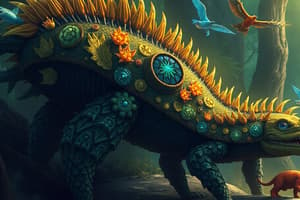Podcast
Questions and Answers
पक्षी किस वर्ग के जीवों के बारे में है?
पक्षी किस वर्ग के जीवों के बारे में है?
- स्तनधारी (correct)
- कीटाधारी
- केवल उन्हें जो स्तनहीन हैं
- रेंगनधारी
किस गुण से पहचाना जा सकता है कि कोई जन्तु रेंगनहीन है?
किस गुण से पहचाना जा सकता है कि कोई जन्तु रेंगनहीन है?
- स्तनहीत (correct)
- संरेखित शरीर
- लकड़ी का संरचना
- कीटाधारी
स्पंज और मछली में कौन-सा समानता है?
स्पंज और मछली में कौन-सा समानता है?
- पंखों की समृद्धि
- लकड़ी का संरचना
- तालियों की कमी
- कोई समानता नहीं है (correct)
कौन-सा पक्षी संरेखित शरीर के साथ होता है?
कौन-सा पक्षी संरेखित शरीर के साथ होता है?
पक्षी किस कारणों से महत्वपूर्ण भूमिका निभाते हैं?
पक्षी किस कारणों से महत्वपूर्ण भूमिका निभाते हैं?
सरिसृप किस कारण समुद्र में भी बसे रहते हैं?
सरिसृप किस कारण समुद्र में भी बसे रहते हैं?
पक्षी किस प्रकार के सींचने का काम करते हैं?
पक्षी किस प्रकार के सींचने का काम करते हैं?
रेंगने वाले कीट अपने प्राणी समुदाय में किस प्रकार के प्रमुख स्रोत होते हैं?
रेंगने वाले कीट अपने प्राणी समुदाय में किस प्रकार के प्रमुख स्रोत होते हैं?
पक्षियों के प्रमुख स्रोत क्या है?
पक्षियों के प्रमुख स्रोत क्या है?
समुद्री प्राणियों का क्या प्रमुख स्रोत है?
समुद्री प्राणियों का क्या प्रमुख स्रोत है?
What does animal behavior encompass?
What does animal behavior encompass?
What is the primary goal of animal conservation?
What is the primary goal of animal conservation?
Why is understanding the animal kingdom important?
Why is understanding the animal kingdom important?
Which phylum of the animal kingdom includes insects, spiders, and crustaceans?
Which phylum of the animal kingdom includes insects, spiders, and crustaceans?
What is a characteristic of animals in the phylum Chordata?
What is a characteristic of animals in the phylum Chordata?
Which class of animals is part of the phylum Annelida?
Which class of animals is part of the phylum Annelida?
What type of organisms does the animal kingdom mainly comprise?
What type of organisms does the animal kingdom mainly comprise?
Flashcards are hidden until you start studying
Study Notes
Animal Kingdom: A Diverse and Wondrous World of Invertebrates, Birds, Reptiles, Amphibians, and Mammals
The animal kingdom is a vast and fascinating world, filled with a diverse range of species, each with their unique characteristics and adaptations. This article will explore the intriguing world of invertebrates, birds, reptiles, amphibians, and mammals, providing an in-depth understanding of their various features, habitats, and behaviors.
Invertebrates: A Hidden World of Diversity
Invertebrates are the most abundant and diverse group of animals on Earth, with over 1 million known species. These animals lack a backbone, and their bodies are not segmented. Invertebrates can be found in almost every imaginable habitat and often play critical roles in ecosystems. Some common examples of invertebrates include insects, spiders, snails, snakes, jellyfish, and starfish.
Invertebrates exhibit a wide range of body forms, from the simple, soft-bodied form of sponges and jellyfish to the more complex body of insects and mollusks. They have various methods of locomotion, such as crawling, swimming, or flying. Some invertebrates, like sponges and jellyfish, are sessile, meaning they have no means of movement.
Birds: Majestic Creatures of the Sky
Birds are a diverse group of warm-blooded, egg-laying, feathered, vertebrate animals. They have beaks, which are highly specialized for various purposes, such as eating, building nests, and communicating. Birds can be found on every continent, except Antarctica, and come in a variety of sizes, from the small hummingbird to the large ostrich.
Birds exhibit a wide range of behaviors, including nesting, migration, and communication. Some species, like parrots and crows, are known for their intelligence and problem-solving skills. Birds play a crucial role in ecosystems, as pollinators, seed dispersers, and controllers of insect populations.
Reptiles: Cold-Blooded, Scaly Creatures
Reptiles are a diverse group of cold-blooded, scaly animals that includes turtles, crocodiles, alligators, lizards, and snakes. They have dry, scaly skin that helps protect them from predators and the environment. Reptiles have a variety of body forms and habits, ranging from the aquatic turtles and crocodiles to the terrestrial lizards and snakes.
Reptiles exhibit a wide range of behaviors, including burrowing, swimming, and climbing trees. Some species, like snakes and chameleons, are known for their amazing camouflage abilities. Reptiles play a crucial role in ecosystems, as predators, prey, and controllers of insect populations.
Amphibians: The Link Between Reptiles and Vertebrates
Amphibians are a group of animals that are both aquatic and terrestrial, and they are the link between reptiles and vertebrates. They have smooth, slimy skin that helps them breathe underwater and move easily on land. Amphibians include frogs, salamanders, newts, and caecilians.
Amphibians exhibit a wide range of behaviors, including swimming, jumping, and burrowing. Some species, like tree frogs and chorus frogs, are known for their vocalizations. Amphibians play a crucial role in ecosystems, as prey, predators, and controllers of insect populations.
Mammals: The Most Diverse and Varied Group of Animals
Mammals are a diverse group of animals that are characterized by their mammary glands, which produce milk to nourish their young. They range in size from the tiny shrew to the large blue whale. Mammals have a wide range of body forms and habits, including burrowing, flying, and swimming.
Mammals exhibit a wide range of behaviors, including socializing, communicating, and building nests. Some species, like dolphins and elephants, are known for their intelligence and social structures. Mammals play a crucial role in ecosystems, as prey, predators, and controllers of insect populations.
In conclusion, the animal kingdom is a vast and fascinating world, filled with a diverse range of species, each with their unique characteristics and adaptations. From the simple invertebrates to the complex mammals, each animal plays a crucial role in its ecosystem, contributing to the delicate balance of life on Earth.
Studying That Suits You
Use AI to generate personalized quizzes and flashcards to suit your learning preferences.




